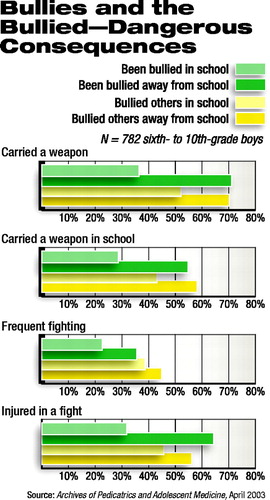Bullies–Not Victims–Pose Greatest Violence Risk
 The schoolyard bully may be even more of a threat than previously thought. New research shows that children who bully others appear to be at risk for engaging in more serious violent behaviors, such as carrying a weapon and frequent fighting.
The schoolyard bully may be even more of a threat than previously thought. New research shows that children who bully others appear to be at risk for engaging in more serious violent behaviors, such as carrying a weapon and frequent fighting.
In fact, researchers at the National Institute of Child Health and Human Development (NICHD) in Bethesda, Md., found that among 782 sixth- to 10th-grade boys who said they had bullied others at least once a week in school, 43 percent carried a weapon to school, and 39 percent reported being involved in frequent fighting. Almost 46 percent had been injured in a fight.
The data appear in the April Archives of Pediatrics and Adolescent Medicine.
To learn more about bullying behaviors, NICHD investigator and lead author Tonja Nansel, Ph.D., surveyed a random sample of 15,686 boys and girls from public and private schools during spring 1998.
This survey was part of a larger survey coordinated by the World Health Organization, which studied the health behavior of school-aged children. That study collected data in 30 countries.
In the U.S. sample, “about 30 percent of youth were involved in moderate or frequent bullying as bullier, target, or both,” Nansel told Psychiatric News.
In addition, the results show that boys were most often the bulliers. For example, of the 7,316 boys in the sample, 10.7 percent bullied others in school on a weekly basis. Of the 8,370 girls, just 4 percent did.
The researchers defined bullying as “when another student, or group of students, say or do nasty and unpleasant things” to their peers or “when a student is teased repeatedly in a way he or she doesn’t like.”
The researchers made a distinction between bullying behaviors in and out of school and found that those who bullied others out of school were at greatest risk for engaging in violence-related behaviors.
When children bully others off school grounds, Nansel explained, adults are less likely to intervene, so the bullying may last longer or be more severe.
Among the 482 boys who said they bullied others at least once a week while away from school, 70.2 percent carried a weapon, 58 percent carried a weapon to school, almost 45 percent said they fought frequently, and 56 percent said they had been injured in a fight.
In addition, Nansel found that boys in this group were six times more likely than boys who had never bullied others to carry a weapon, five times more likely to carry a weapon to school, and 3.5 times more likely to be involved in frequent fighting.
Nansel said that in recent years, a number of highly publicized incidents “raised the question as to what extent being bullied is associated with [later] violent behavior.”
The 1999 Columbine High School shooting incident is just one example. Shooters Eric Harris, 18, and Dylan Klebold, 17, who fatally shot 12 classmates and one teacher, were known to be victims of bullying by classmates.
The study found elevated risk of committing violent behaviors for the 623 boys who had been bullied by others at least once a week in school—28.7 percent carried a weapon to school, 22.6 percent said they were involved in frequent fighting, and 31.8 percent said they had been injured in a fight.
Nansel cited a 1993 Norwegian study led by Dan Orweus, Ph.D., which found that chronically victimized students may later be at increased risk for depression, poor self-esteem, and other mental health problems.
“Our findings highlight the importance of violence-prevention efforts aimed not only at helping children who are bullied, but those who bully, who are at greater risk for aggressive behavior,” Nansel said.
An abstract of the study, “Relationships Between Bullying and Violence Among U.S. Youth,” is posted on the Web at www.archpedi.ama-assn.org. ▪



